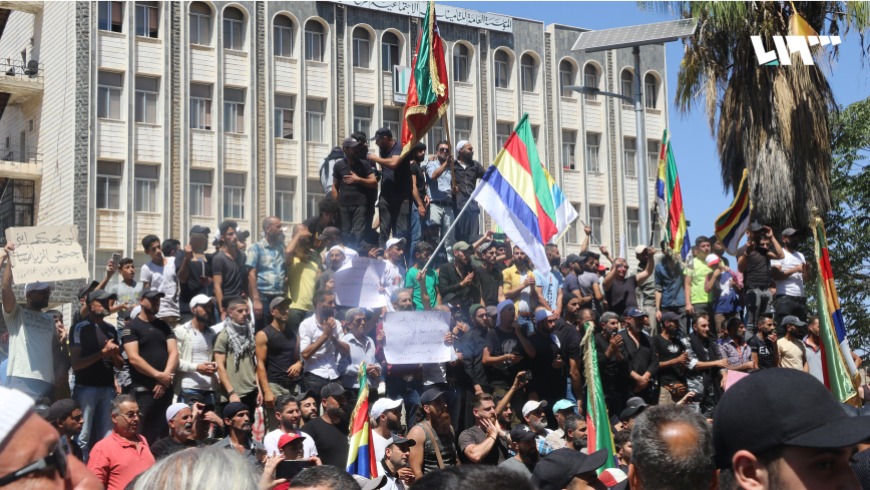The ongoing popular movement in Suweida has now reached its 11th day, with demonstrations persistently demanding the removal of the Syrian regime and President Bashar al-Assad. The momentum of the movement remains strong, as protesters rally under the banners of the Syrian revolution. This stands in contrast to the regime’s attempts to quell the movement through various tactics of manipulation and deceit.
Despite the regime’s efforts to exploit notions of “separation” in order to establish autonomy in southern Suweida, the movement remains steadfast in its commitment to national unity. Its core demands continue to focus on the overthrow of the regime and the departure of President Bashar al-Assad. Alongside these demands, the movement also highlights the importance of Syrian unity and the activation of Security Council Resolution 2254. This resolution advocates for a political transition overseen by the United Nations.
Suweida and Saudi Arabia Secretly Push Hossam Louqa to Beirut: Hezbollah Provoked
Interestingly, it appears that the Syrian regime has opted not to directly confront the ongoing movement in Suweida. Instead, it seems to be banking on the passage of time, hoping that the governorate’s residents will eventually tire from sustained civil disobedience and the economic strains caused by the closure of commercial activities.
Nonetheless, the determination of the protesters in Suwayda remains resolute, undeterred by the regime’s tactics. As the movement enters its second week, its participants continue to champion their cause for change, utilizing the power of their unified voices to call for a new political future for Syria under the auspices of international cooperation.
Creating internal division
The regime’s strategy involves sowing discord among the residents of Suweida itself, utilizing an alternate narrative that emerges from within the governorate. Suweida is predominantly inhabited by the Druze community, but there exists a rift among the prominent sheikhs. While Sheikh Hikmat al-Hijri and Sheikh Hamoud al-Hinnawi endorse the popular movement and its demonstrations, aligning with the people’s demands, the Syrian regime has engaged Sheikh Youssef Jarbou, the third sheikh of the sect, who has taken a stance in support of the regime.
Sources with insight into the matter have revealed to the local Suwayda 24 network that Safwan Abu Saada, a native of Suweida and a representative of Bashar al-Assad, arrived in the city on Tuesday. He convened with Sheikh Jarbou and several influential figures from the city. A video recording of this meeting has gained widespread attention, wherein Sheikh Jarbou discusses his opposition to the idea of secession – a notion that the ongoing popular movement in Suweida vehemently rejects, as echoed in the chants of its participants.
The regime’s approach seeks to exploit existing divisions and disagreements within Suweida’s community, attempting to amplify dissenting voices and perspectives that align with its own agenda. This maneuver aims to counteract the unifying strength of the popular movement, which remains steadfast in its demand for change and rejection of any separatist tendencies.
As the regime employs this tactic to undermine the unity of the movement, the resolute voices of Sheikh Hijri and Sheikh Hinnawi, alongside the unwavering commitment of the movement’s participants, serve as a testament to the people’s determination to resist such divisive efforts and pursue their goals of regime change and national transformation.
Traitors, spies, separatists
The media associated with the regime and closely aligned with it have been actively promoting a seditious narrative against the demonstrators in Suwayda. This narrative falsely labels the protesters as foreign agents pursuing a separatist agenda, allegedly supported by the United States and Israel. This misleading portrayal aims to depict the demonstrators as individuals seeking to arm themselves and turn their movement into a militarized campaign. This disinformation campaign is reminiscent of the tactics used against the Syrian revolutionaries in 2011, with the notable distinction that, as of now, the regime has refrained from employing violent suppression against the protests in Suweida.
Despite these efforts, the demonstrators congregating at al-Karama Square within Suweida vehemently reject any endeavors to transform their revolutionary cause into an armed conflict. They are resolute in their commitment to a peaceful approach, steadfastly pursuing their objectives for political reform and change, as mandated by international resolutions.
ISIS
During the years when ISIS was active in the Syrian desert near Suweida, the Assad regime manipulated the group’s activities, redirecting its focus towards the Druze-majority governorate. This strategy aimed to both coerce the governorate and convey an external message, showcasing the regime’s role in safeguarding minorities from the perils of terrorism.
Numerous activists in Suweida have raised concerns that the regime could potentially employ a similar tactic once again, by transporting ISIS militants to infiltrate certain areas within Suweida. This scheme would likely involve perpetrating atrocities akin to the tragic incident in July 2018. During that event, approximately 150 individuals from the governorate lost their lives, and almost 200 others sustained injuries. The objective behind such brutal acts would be to pressure Druze leaders into permitting local youth to enlist in the military.
Nevertheless, the current weakened state of the organization may render this strategy less feasible, especially due to the presence of civil committees actively operating within Suweida. These committees have been diligently working to thwart the movement of individuals in and out of the governorate, thereby maintaining security within the various villages and towns. Their efforts play a pivotal role in preventing emergency situations that could compromise the stability of the region.
This article was translated and edited by The Syrian Observer. The Syrian Observer has not verified the content of this story. Responsibility for the information and views set out in this article lies entirely with the author.


